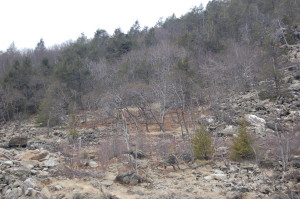Hazard Profile
Palmerton is the site of two separate primary zinc smelting operations from 1898-1980. SO2 and metal pollution from the sites denuded surrounding mountains, which present a scene that is dramatically different from nearby forested mountains. While there are other ways of being exposed to lead, Palmerton is exposed mainly through soil contamination. The area has some of the highest known soil lead levels, as well as significant cadmium, arsenic, and zinc contamination.
In 1980, the West Plant closed and the East Plant transitioned to a secondary metal refining and processing operation.
In 1982, the site was placed on the National Priorities (“superfund”) List, and has been the subject of health assessments by ATSDR (1993) and more recently the Pennsylvania Department of Health.
Continuing environmental health issues at Palmerton include permit issues for operation of the sites and recent observations of elevated lead levels in children.
What is Lead?
Lead is a heavy metal and basic chemical element. Lead is also a poison. It can slow mental and physical growth and make you very sick. For these reasons, knowing where lead might show up in your environment can help you to avoid contact with it!
Childhood lead poisoning is still one of the most important health issues in the United States today. According to recent Centers for Disease Control and Prevention (CDC) estimates, 890,000 US children age 1-5 have elevated blood lead levels that may harm their health and development.
Sources of Lead and What You Can Do |
|
House Paint |
|
|
Homes built before 1977 likely contain lead-based paint and old paint flakes off. |
∙ Don’t sand off old paint. Let your landlord know about chipping paint. ∙ Wet mop and dust often. |
Soil |
|
|
Soil (dirt) near heavily-used streets, old homes, old factories, and even playgrounds may contain lead. |
∙ Wash hands after playing outside. ∙ Hand sanitizer does not remove lead. |
Drinking Water |
|
|
Lead may get into drinking water when materials used in plumbing contain lead. Well water can become contaminated at anytime. |
∙ Run the water for 10 minutes before drinking, cooking, or making baby formula. ∙ Test well water annually. |
Others |
|
|
Lead is also found in some imported children’s toys, candy, and cosmetics |
∙ Be aware of the items you are buying and consuming. |
Health Profile
- Many citizens suffer from continued exposure to lead and zinc.
- Lead poisoning can affect nearly every system in the body and frequently goes unrecognized because it often occurs with no obvious symptoms.
- Lead poisoning can cause learning disabilities, slowed growth, hearing loss, and behavioral problems. At very high levels, lead poisoning can cause seizures, coma, and death.
COEC Activities in Palmerton
We use the case study of Palmerton to teach risk assessment and hazard abatement to students in our MPH program. High school and college students in the TREES and STEER programs take a field trip to Palmerton, hosted by Palmerton Citizens for a Clean Environment and the EPA. The students have described the trip as a highlight of their experience.
The Frontiers course for fourth year medical students visits the site and meets with residents and administrators for the city. The course provides the unique opportunity for physicians in training to understand a variety of perspectives that are offered by different factions of the community that has experienced a major environmental disaster.
Dr. Sulagna De (a resident in the Occupational and Environmental Medicine Program) worked with Dr. Edward Emmett to address the Palmerton situation in both her Environmental Health and Epidemiology rotation projects. Dr. De’s work resulted in a recommendation for a new round of blood lead testing for Palmerton children. The Pennsylvania Department of Health adopted her recommendation and made free testing available to children.
Demographic Information
People QuickFacts |
Palmerton |
Pennsylvania |
| Population, 2012 estimate | 5,377 | 12,763,536 |
| Population, percent change, April 1, 2010 to July 1, 2012 | -0.70% | 0.50% |
| Population, 2010 | 5,414 | 12,702,379 |
Education |
Palmerton |
Pennsylvania |
| High school graduate or higher, percent of persons age 25+, 2007-2011 | 85.20% | 87.90% |
| Bachelor’s degree or higher, percent of persons age 25+, 2007-2011 | 14.50% | 26.70% |
| Veterans, 2007-2011 | 424 | 1,007,939 |
| Mean travel time to work (minutes), workers age 16+, 2007-2011 | 26 | 25.7 |
Housing |
||
| Housing units, 2010 | 2,436 | 5,567,315 |
| Homeownership rate, 2007-2011 | 72.60% | 70.60% |
| Housing units in multi-unit structures, percent, 2007-2011 | 19.40% | 20.50% |
| Median value of owner-occupied housing units, 2007-2011 | $115,400 | $163,200 |
| Households, 2007-2011 | 2,467 | 4,952,566 |
| Persons per household, 2007-2011 | 2.2 | 2.47 |
Income |
||
| Per capita money income in the past 12 months (2011 dollars), 2007-2011 | $22,212 | $27,824 |
| Median household income, 2007-2011 | $44,183 | $51,651 |
| Persons below poverty level, percent, 2007-2011 | 12.90% | 12.60% |





